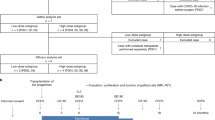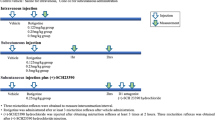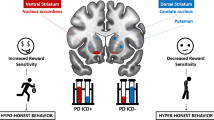Abstract
The dopamine agonist pramipexole (PPX) can increase impulsiveness, and PPX therapy for neurological diseases (Parkinson's disease (PD) and restless leg syndrome) is associated with impulse control disorders (ICDs) in subpopulations of treated patients. A commonly reported ICD is pathological gambling of which risk taking is a prominent feature. Probability discounting is a measurable aspect of risk taking. We recently developed a probability discounting paradigm wherein intracranial self-stimulation (ICSS) serves as the positive reinforcer. Here we used this paradigm to determine the effects of PPX on discounting. We included assessments of a rodent model of PD, wherein 6-OHDA was injected into the dorsolateral striatum of both hemispheres, which produced persistent PD-like deficits in posture adjustment. Rats were trained to perform ICSS-mediated probability discounting, in which PD-like and control groups exhibited similar profiles. Rats were treated twice daily for 2 weeks with 2 mg/kg (±)PPX (ie, 1 mg/kg of the active form), a dose that improved lesion-induced motor deficits. In both groups, (±)PPX increased discounting; preference for the large reinforcer was enhanced 30–45% at the most uncertain probabilities. Tolerance did not develop with repeated treatments. Increased discounting subsided within 2 weeks of (±)PPX cessation, and re-exposure to (±)PPX reinstated heightened discounting. Such findings emulate the clinical scenario; therefore, ICSS for discounting assessments in rats exhibited high face validity. This model should prove useful in medication development where assessment of the propensity of a putative therapy to induce risk-taking behaviors is of interest.
Similar content being viewed by others
Log in or create a free account to read this content
Gain free access to this article, as well as selected content from this journal and more on nature.com
or
References
Abler B, Hahlbrock R, Unrath A, Gron G, Kassubek J (2009). At-risk for pathological gambling: imaging neural reward processing under chronic dopamine agonists. Brain 132: 2396–2402.
Bodi N, Keri S, Nagy H, Moustafa A, Myers CE, Daw N et al (2009). Reward-learning and the novelty-seeking personality: a between- and within-subjects study of the effects of dopamine agonists on young Parkinson's patients. Brain 132: 2385–2395.
Bonuccelli U, Del DP, Rascol O (2009). Role of dopamine receptor agonists in the treatment of early Parkinson's disease. Parkinsonism Relat Disord 15 (Suppl 4): S44–S53.
Buckholtz JW, Treadway MT, Cowan RL, Woodward ND, Li R, Ansari MS et al (2010). Dopaminergic network differences in human impulsivity. Science 329: 532.
Caine SB, Koob GF, Parsons LH, Everitt BJ, Schwartz JC, Sokoloff P (1997). D3 receptor test in vitro predicts decreased cocaine self- administration in rats. Neuroreport 8: 2373–2377.
Chang JW, Wachtel SR, Young D, Kang UJ (1999). Biochemical and anatomical characterization of forepaw adjusting steps in rat models of Parkinson's disease: studies on medial forebrain bundle and striatal lesions. Neuroscience 88: 617–628.
Chernoloz O, El MM, Blier P (2009). Sustained administration of pramipexole modifies the spontaneous firing of dopamine, norepinephrine, and serotonin neurons in the rat brain. Neuropsychopharmacology 34: 651–661.
Collins GT, Calinski DM, Newman AH, Grundt P, Woods JH (2008). Food restriction alters N′-propyl-4,5,6,7-tetrahydrobenzothiazole-2,6-diamine dihydrochloride (pramipexole)-induced yawning, hypothermia, and locomotor activity in rats: evidence for sensitization of dopamine D2 receptor-mediated effects. J Pharmacol Exp Ther 325: 691–697.
Collins GT, Newman AH, Grundt P, Rice KC, Husbands SM, Chauvignac C et al (2007). Yawning and hypothermia in rats: effects of dopamine D3 and D2 agonists and antagonists. Psychopharmacology (Berl) 193: 159–170.
Collins GT, Truccone A, Haji-Abdi F, Newman AH, Grundt P, Rice KC et al (2009). Proerectile effects of dopamine D2-like agonists are mediated by the D3 receptor in rats and mice. J Pharmacol Exp Ther 329: 210–217.
Collins GT, Witkin JM, Newman AH, Svensson KA, Grundt P, Cao J et al (2005). Dopamine agonist-induced yawning in rats: a dopamine D3 receptor-mediated behavior. J Pharmacol Exp Ther 314: 310–319.
Cools R, Altamirano L, D'Esposito M (2006). Reversal learning in Parkinson's disease depends on medication status and outcome valence. Neuropsychologia 44: 1663–1673.
Deumens R, Blokland A, Prickaerts J (2002). Modeling Parkinson's disease in rats: an evaluation of 6-OHDA lesions of the nigrostriatal pathway. Exp Neurol 175: 303–317.
Dodd ML, Klos KJ, Bower JH, Geda YE, Josephs KA, Ahlskog JE (2005). Pathological gambling caused by drugs used to treat Parkinson disease. Arch Neurol 62: 1377–1381.
Driver-Dunckley ED, Noble BN, Hentz JG, Evidente VG, Caviness JN, Parish J et al (2007). Gambling and increased sexual desire with dopaminergic medications in restless legs syndrome. Clin Neuropharmacol 30: 249–255.
Evans AH, Strafella AP, Weintraub D, Stacy M (2009). Impulsive and compulsive behaviors in Parkinson's disease. Mov Disord 24: 1561–1570.
Ghods-Sharifi S, St Onge JR, Floresco SB (2009). Fundamental contribution by the basolateral amygdala to different forms of decision making. J Neurosci 29: 5251–5259.
Hamidovic A, Kang UJ, de WH (2008). Effects of low to moderate acute doses of pramipexole on impulsivity and cognition in healthy volunteers. J Clin Psychopharmacol 28: 45–51.
Heidbreder CA, Gardner EL, Xi ZX, Thanos PK, Mugnaini M, Hagan JJ et al (2005). The role of central dopamine D3 receptors in drug addiction: a review of pharmacological evidence. Brain Res Brain Res Rev 49: 77–105.
Heidbreder CA, Newman AH (2010). Current perspectives on selective dopamine D(3) receptor antagonists as pharmacotherapeutics for addictions and related disorders. Ann NY Acad Sci 1187: 4–34.
Holman AJ (2009). Impulse control disorder behaviors associated with pramipexole used to treat fibromyalgia. J Gambl Stud 25: 425–431.
Holt DD, Green L, Myerson J (2003). Is discounting impulsive? Evidence from temporal and probability discounting in gambling and non-gambling college students. Behav Processes 64: 355–367.
Johnson PS, Madden GJ, Brewer AT, Pinkston JW, Fowler SC (2011). Effects of acute pramipexole on preference for gambling-like schedules of reinforcement in rats. Psychopharmacology (Berl) 231: 11–18.
Kish SJ, Shannak K, Hornykiewicz O (1988). Uneven pattern of dopamine loss in the striatum of patients with idiopathic Parkinson's disease. Pathophysiologic and clinical implications. N Engl J Med 318: 876–880.
Macphee GJ, Copeland C, Stewart D, Grosset K, Grosset DG (2009). Clinical follow up of pathological gambling in Parkinson's disease in the West Scotland study. Mov Disord 24: 2430–2431.
Madden GJ, Petry NM, Johnson PS (2009). Pathological gamblers discount probabilistic rewards less steeply than matched controls. Exp Clin Psychopharmacol 17: 283–290.
Maj J, Rogoi Z, Margas W, Kata M, Dziedzicka-Wasylewska M (2000). The effect of repeated treatment with pramipexole on the central dopamine D3 system. J Neural Transm 107: 1369–1379.
Mamikonyan E, Siderowf AD, Duda JE, Potenza MN, Horn S, Stern MB et al (2008). Long-term follow-up of impulse control disorders in Parkinson's disease. Mov Disord 23: 75–80.
Olsson M, Nikkhah G, Bentlage C, Bjorklund A (1995). Forelimb akinesia in the rat Parkinson model: differential effects of dopamine agonists and nigral transplants as assessed by a new stepping test. J Neurosci 15: 3863–3875.
Paxinos G, Watson C (1998). The Rat Brain in Stereotaxic Coordinates. Academic Press: New York.
Petry NM (2011). Discounting of probabilistic rewards is associated with gambling abstinence in treatment-seeking pathological gamblers. J Abnorm Psychol; e-pub ahead of print 15 August 2011.
Pizzagalli DA, Evins AE, Schetter EC, Frank MJ, Pajtas PE, Santesso DL et al (2008). Single dose of a dopamine agonist impairs reinforcement learning in humans: behavioral evidence from a laboratory-based measure of reward responsiveness. Psychopharmacology (Berl) 196: 221–232.
Pourcher E, Remillard S, Cohen H (2010). Compulsive habits in restless legs syndrome patients under dopaminergic treatment. J Neurol Sci 290: 52–56.
Przedborski S, Levivier M, Jiang H, Ferreira M, Jackson-Lewis V, Donaldson D et al (1995). Dose-dependent lesions of the dopaminergic nigrostriatal pathway induced by intrastriatal injection of 6-hydroxydopamine. Neuroscience 67: 631–647.
Quickfall J, Suchowersky O (2007). Pathological gambling associated with dopamine agonist use in restless legs syndrome. Parkinsonism Relat Disord 13: 535–536.
Riba J, Kramer UM, Heldmann M, Richter S, Munte TF (2008). Dopamine agonist increases risk taking but blunts reward-related brain activity. PLoS ONE 3: e2479.
Riddle JL, Rokosik SL, Napier TC (2010). Pramipexole induces a conditioned place preference in parkinsonian-like and control rats. Program No 813 21, 2010. Neuroscience Meeting Planner, San Diego, CA: Society for Neuroscience, 2010 Online.
Rokosik SL, Napier TC (2011). Intracranial self-stimulation as a positive reinforcer to study impulsivity in a probability discounting paradigm. J Neurosci Methods 198: 260–269.
Santesso DL, Evins AE, Frank MJ, Schetter EC, Bogdan R, Pizzagalli DA (2009). Single dose of a dopamine agonist impairs reinforcement learning in humans: evidence from event-related potentials and computational modeling of striatal-cortical function. Hum Brain Mapp 30: 1963–1976.
Seedat S, Kesler S, Niehaus DJ, Stein DJ (2000). Pathological gambling behaviour: emergence secondary to treatment of Parkinson's disease with dopaminergic agents. Depress Anxiety 11: 185–186.
Self DW (1998). Neural substrates of drug craving and relapse in drug addiction. Ann Med 30: 379–389.
St Onge JR, Chiu YC, Floresco SB (2010). Differential effects of dopaminergic manipulations on risky choice. Psychopharmacology (Berl) 211: 209–221.
St Onge JR, Floresco SB (2009). Dopaminergic modulation of risk-based decision making. Neuropsychopharmacology 34: 681–697.
Strejilevich SA, Martino DJ, Igoa A, Manes F (2011). Pathological gambling in a bipolar patient treated with pramipexole. J Neuropsychiatry Clin Neurosci 23: E2–E3.
Tippmann-Peikert M, Park JG, Boeve BF, Shepard JW, Silber MH (2007). Pathologic gambling in patients with restless legs syndrome treated with dopaminergic agonists. Neurology 68: 301–303.
van Eimeren T, Ballanger B, Pellecchia G, Miyasaki JM, Lang AE, Strafella AP (2009). Dopamine agonists diminish value sensitivity of the orbitofrontal cortex: a trigger for pathological gambling in Parkinson's disease? Neuropsychopharmacology 34: 2758–2766.
van Gaalen MM, Unger L, Jongen-Relo AL, Schoemaker H, Gross G (2009). Amphetamine decreases behavioral inhibition by stimulation of dopamine D2, but not D3, receptors. Behav Pharmacol 20: 484–491.
Voon V, Fox SH (2007). Medication-related impulse control and repetitive behaviors in Parkinson disease. Arch Neurol 64: 1089–1096.
Weintraub D, Koester J, Potenza MN, Siderowf AD, Stacy M, Voon V et al (2010). Impulse control disorders in Parkinson disease: a cross-sectional study of 3090 patients. Arch Neurol 67: 589–595.
Acknowledgements
We thank Jennifer L Riddle for her excellent technical assistance. This work was supported by the Michael J Fox Foundation, the Parkinson's Disease Foundation, Parkinson's Research Center at Rush University, and the Daniel F and Ada L Rice Foundation.
Author information
Authors and Affiliations
Corresponding author
Ethics declarations
Competing interests
The authors declare no conflict of interest.
Rights and permissions
About this article
Cite this article
Rokosik, S., Napier, T. Pramipexole-Induced Increased Probabilistic Discounting: Comparison Between a Rodent Model of Parkinson's Disease and Controls. Neuropsychopharmacol 37, 1397–1408 (2012). https://doi.org/10.1038/npp.2011.325
Received:
Revised:
Accepted:
Published:
Issue date:
DOI: https://doi.org/10.1038/npp.2011.325
Keywords
This article is cited by
-
Noradrenergic contributions to cue-driven risk-taking and impulsivity
Psychopharmacology (2021)
-
Motor impulsivity and delay intolerance are elicited in a dose-dependent manner with a dopaminergic agonist in parkinsonian rats
Psychopharmacology (2020)
-
Increased motor impulsivity in a rat gambling task during chronic ropinirole treatment: potentiation by win-paired audiovisual cues
Psychopharmacology (2019)
-
The neurobiology of impulse control disorders in Parkinson’s disease: from neurotransmitters to neural networks
Cell and Tissue Research (2018)
-
Impulse control disorders in Parkinson’s disease
Journal of Neural Transmission (2018)



